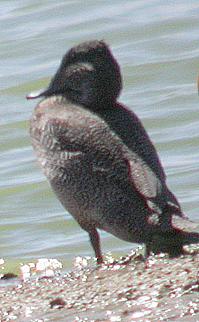- Freckled Duck
Taxobox
name = Freckled Duck
status = LC | status_system = IUCN3.1

regnum =Animalia
phylum = Chordata
classis = Aves
ordo =Anseriformes
familia =Anatidae
subfamilia = Stictonettinae"
genus = "Stictonetta"
genus_authority = Reichenbach,1853
species = "S. naevosa"
binomial = "Stictonetta naevosa"
binomial_authority = (Gould,1841 )The Freckled Duck ("Stictonetta naevosa") is a moderately large, broad-bodied
duck native to southernAustralia . The duck is protected by law. Dark in colour with fine off-white speckles all over, it is most easily identified by its large head with a peaked (as opposed to rounded) crown.This species was formerly allied with the
dabbling duck s, but is now placed in amonotypic subfamily Stictonettinae. It appears to be part of anGondwana n radiation of waterfowl, before trueduck s evolved (Sraml "et al." 1996).The Freckled Duck feeds by dabbling in shallow water, often by wading near the edge. It prefers large, well-vegetated swamps, but moves to open water after breeding or in dry periods.
In flight, it has a distinctive rapid wing beat and holds its head low, making it look rather hunchbacked. It does not turn rapidly and lands clumsily.
In dry years, the ephemeral wetlands of the
Murray-Darling Basin andLake Eyre disappear and Freckled Ducks migrate to permanent water in coastal regions. This concentration in populated areas, coupled with their habit of circling repeatedly at low altitude when disturbed (even when being shot at) makes them particularly vulnerable to hunting.Although protected by law in all states, the reality is that hunters continue to shoot Freckled Duck. During the 1979-83 drought, for example, the population was reduced by about 5%. There have been steps taken to require shooters to pass a waterfowl identification test in Victoria (the state where, because of the nature of the wetlands, Freckled Duck are most vulnerable) and to make pre-season surveys of Freckled Duck numbers in wetlands so as to temporarily close areas to shooting, but it is too early to know how effective these changes will be.
In the longer-term, the key survival issue for Freckled Duck is likely to be habitat rather than hunting. Vast areas of former wetlands in the interior have been drained and cleared for agriculture, the remaining areas are threatened by salinity, by the diversion of water to supply cities and farms, and by long-term climate change: as rains come less often and higher average temperatures increase evaporation, Australia's inland wetlands become less able to sustain life.
References
* Database entry includes a lengthy justification of why this species is of least concern
* Sraml, M.; Christidis, L.; Easteal, S.; Horn, P. & Collet, C. (1996): Molecular Relationships Within Australasian Waterfowl (Anseriformes). "Australian Journal of Zoology" 44(1): 47-58. DOI|10.1071/ZO9960047 (HTML abstract)
Wikimedia Foundation. 2010.
